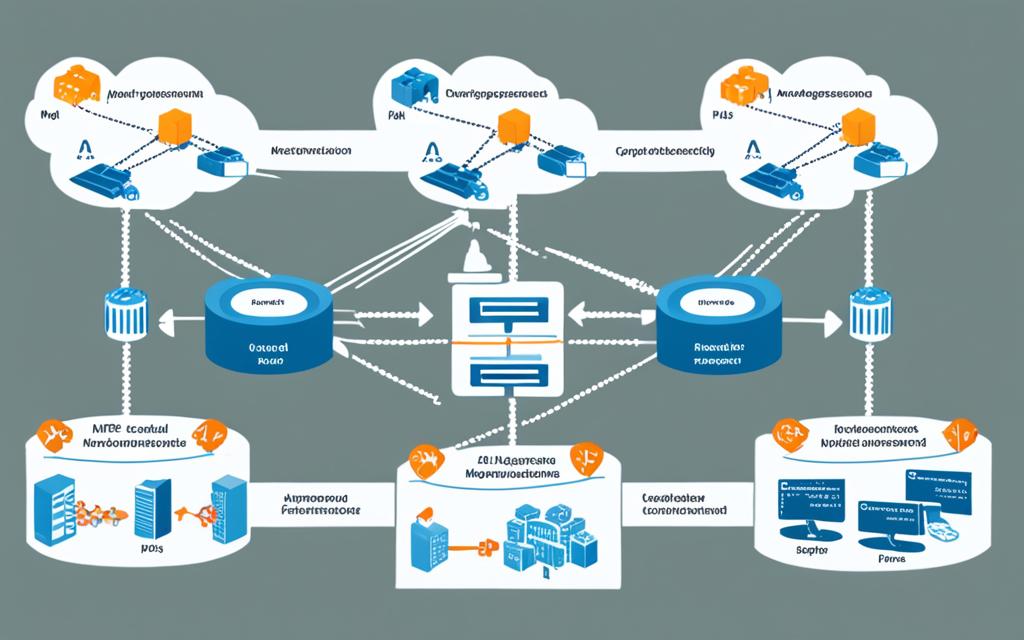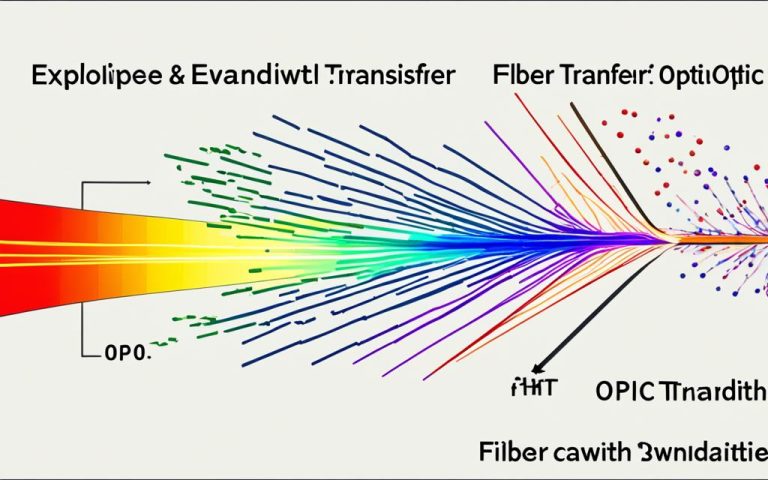Multiprotocol Label Switching (MPLS) is a vital technology that enhances the efficiency of data flow in fiber networks. By utilizing labels instead of network addresses, MPLS optimizes routing, resulting in shorter pathways and improved speed and quality of service (QoS). Widely adopted in modern communication infrastructures, MPLS has revolutionized the way data is transmitted in wide area networks (WANs).
MPLS plays a crucial role in optimizing data transmission in fiber networks. It leverages the inherent advantages of fiber optics, such as high bandwidth and low latency, to deliver exceptional performance. With MPLS, businesses can effectively manage and prioritize their data traffic, ensuring that critical applications receive the necessary resources and maintaining a seamless user experience.
Whether it is streaming high-definition videos, conducting real-time communications, or transferring large amounts of data, MPLS enables organizations to achieve efficient data flow in their fiber networks. It eliminates the limitations of traditional routing mechanisms and empowers businesses to optimize their network infrastructure for maximum performance and scalability.
In the following sections, we will explore the concept of MPLS in more detail, including its history, components, and benefits in fiber networks. We will also discuss its real-world applications and the role it plays in modern network environments. Stay tuned to discover how MPLS can elevate the efficiency of your data flow and unlock new possibilities in your fiber network infrastructure.
What is MPLS and Its History?
MPLS, which stands for Multiprotocol Label Switching, is a protocol-agnostic traffic routing technology commonly used in Wide Area Networks (WANs). Unlike traditional routing mechanisms that rely on network addresses, MPLS uses labels to determine the optimal path for data packets, resulting in reduced downtime, improved speed, and enhanced Quality of Service (QoS).
MPLS was developed in the late 1990s as a solution to handle the increasing bandwidth demands of the internet. Traditional routing mechanisms struggled to keep up with the load, resulting in degraded performance for real-time applications. MPLS routers, on the other hand, do not rely heavily on routing tables, allowing for faster network traffic.
One of the key advantages of MPLS is its protocol-agnostic nature. It can work seamlessly with various network protocols, making it adaptable to different network environments. As new technologies emerge, MPLS continues to evolve and integrate, ensuring its relevance and efficacy in modern communication infrastructures.
To illustrate the growth and utilization of MPLS over time, here is a table showcasing the increasing bandwidth demands and the corresponding need for MPLS:
| Year | Bandwidth Demands | Adoption of MPLS |
|---|---|---|
| 1990s | Low to Moderate | Initial Development |
| Early 2000s | Moderate to High | Widespread Deployment |
| Present | High to Very High | Integral Component of WANs |
As the table demonstrates, the bandwidth demands have significantly increased over time, highlighting the necessity for MPLS in modern network infrastructures.
MPLS has proven to be a reliable and efficient solution for traffic routing in WANs. In the next section, we will explore the various components and the working of MPLS in more detail.
Components and Working of MPLS
Multiprotocol Label Switching (MPLS) operates using a unique set of components that facilitate efficient data flow in fiber networks. Its defining characteristic is the use of labels instead of traditional network addresses.
Labels:
MPLS relies on four-byte labels, acting as identifiers that determine the forwarding path of data packets within the MPLS network. These labels provide a concise and efficient means of routing data, resulting in optimized data transmission pathways and improved network performance.
Operating Layers:
MPLS functions between the data link layer (Layer 2) and the routing layer (Layer 3) of the OSI model. It seamlessly integrates with these layers to enhance the routing and forwarding of data packets.
Ingress and Egress Routers:
When a packet enters an MPLS network, it is assigned a label by the ingress router. This label is used to determine the packet’s optimal pathway through the MPLS network. The label switch routers within the network interpret these labels and direct the packets along the appropriate pathways to their destinations.
At the egress router, the labels are removed, and the packet is forwarded to the final destination using standard IP routing protocols.
Data Link Layer and Routing Layer Integration:
MPLS operates at the convergence of the data link layer and the routing layer, leveraging the advantages of both to optimize data transmission.
While the data link layer focuses on physical transmission, the routing layer is responsible for determining the most efficient path for data packets. By integrating these layers, MPLS achieves enhanced performance and quality of service.

By utilizing labels, MPLS streamlines data transmission pathways, enabling networks to efficiently handle data traffic in fiber networks.
Next, we’ll explore the benefits that MPLS brings to fiber networks, including improved efficiency, speed, and quality of service.
Benefits of MPLS in Fiber Networks
MPLS offers several advantages in fiber networks. By optimizing data transmission paths and reducing latency, MPLS significantly improves efficiency and speed. This optimized routing leads to faster delivery of data packets, ensuring a seamless user experience and efficient resource utilization.
One of the key benefits of MPLS is its ability to prioritize critical applications and deliver Quality of Service (QoS) guarantees. This ensures that time-sensitive or high-priority data, such as voice and video traffic, is prioritized over less time-sensitive data. As a result, MPLS enables enhanced performance for real-time applications and improves overall network reliability.
MPLS also enables the creation of secure and isolated virtual private networks (VPNs) within a network infrastructure. By implementing MPLS-based VPNs, organizations can establish secure communication channels that are isolated from public networks. This enhances data privacy and prevents unauthorized access to sensitive information.
Another significant advantage of MPLS is its ability to enhance network security. MPLS utilizes unique identifiers, known as labels, to isolate and route data packets. These labels provide an additional layer of security by preventing unauthorized users from intercepting or manipulating network traffic.
MPLS offers scalability, allowing businesses to easily provision and adjust their network bandwidth according to their needs. This scalability is particularly beneficial for organizations that experience fluctuating network traffic or have dynamic bandwidth requirements. By paying for the bandwidth they need, businesses can optimize their network costs and ensure efficient resource allocation.
Moreover, MPLS simplifies network management by providing a centralized control mechanism. This centralized control allows for efficient traffic engineering and simplifies the implementation of Quality of Service policies. Network administrators can easily prioritize different types of traffic and allocate network resources accordingly.
MPLS is well-suited for supporting cloud computing and data center environments. Its ability to prioritize traffic and establish secure connections makes it an ideal solution for connecting remote offices and data centers reliably and efficiently. MPLS ensures that data transfers between different locations are fast, secure, and reliable, enabling organizations to leverage the full potential of cloud-based applications and services.
| Benefits of MPLS in Fiber Networks |
|---|
| Improved efficiency and speed |
| Prioritization of critical applications |
| Secure and isolated VPNs |
| Enhanced network security |
| Scalability and flexible bandwidth provisioning |
| Simplified network management |
| Support for cloud computing and data centers |

MPLS in Modern Network Applications
MPLS, being a versatile technology, has found numerous applications in modern network environments. Its unique capabilities have enabled its adoption across various industries, providing efficient and secure solutions for a range of network requirements.
Finance
In the finance sector, where secure and seamless financial transactions are of utmost importance, MPLS plays a vital role. By leveraging MPLS in their networks, financial institutions can ensure the privacy and integrity of sensitive financial data, enabling secure communication between branches, data centers, and trading platforms. This technology facilitates fast and reliable transactions, making it an ideal choice for the finance industry.
Healthcare
MPLS is widely used in the healthcare industry to support the transfer of patient records, medical imaging, and other critical healthcare data. With MPLS, healthcare providers can establish secure and efficient networks that enable the seamless transmission of sensitive patient information. This technology enhances the speed and accuracy of sharing medical data, contributing to improved patient care and treatment outcomes.
Educational Institutions
Educational institutions increasingly rely on MPLS to build efficient networks that support online learning and collaboration. By prioritizing educational applications and ensuring reliable connectivity among campuses, MPLS enables uninterrupted learning experiences for students and educators. It facilitates the seamless transfer of large volumes of data, such as multimedia content and online course materials, optimizing the educational process.
Enterprise Networks
In the corporate world, MPLS is integrated into wide area networks (WANs) to optimize network performance and security. Enterprises utilize MPLS to prioritize critical applications, ensuring their efficient delivery and reducing latency. MPLS also enables the establishment of secure connections between different offices, allowing organizations to build reliable and scalable networks that meet their specific requirements.
Internet Service Providers
Internet Service Providers (ISPs) leverage MPLS to deliver efficient network services to their customers. By implementing MPLS in their infrastructure, ISPs can offer improved network performance, reliable data transmission, and enhanced quality of service. MPLS allows for efficient traffic routing and bandwidth management, ensuring a seamless internet experience for end-users.
Cloud Computing and Data Centers
MPLS plays a critical role in facilitating seamless connectivity and data transfer in cloud computing and data center environments. By utilizing MPLS, organizations can establish secure, high-speed connections between their on-premises infrastructure and cloud platforms. This enables efficient data migration, supports real-time applications, and enhances overall performance in cloud-based environments.
In summary, MPLS has become an indispensable technology in modern network applications. It provides the foundation for secure and efficient communication in finance, healthcare, education, enterprise networks, ISPs, and cloud computing. The versatility and reliability of MPLS make it an essential tool for businesses and organizations seeking to optimize their network infrastructure and enhance their digital capabilities.
Conclusion
Multiprotocol Label Switching (MPLS) is a vital technology that optimizes data flow in fiber networks, providing increased efficiency, scalability, and enhanced performance. By utilizing labels for packet forwarding, MPLS streamlines network traffic and reduces latency, resulting in improved speed and quality of service. Its integration with Software-Defined Wide Area Networking (SD-WAN) creates a dynamic and adaptable networking solution that can deliver cost savings and improve network infrastructure.
MPLS’s efficiency lies in its ability to prioritize critical applications, ensuring they receive the necessary bandwidth and minimizing disruptions. With its scalable nature, businesses can easily provision and pay for the bandwidth they require, allowing for flexible network expansion. Additionally, MPLS offers enhanced security through unique identifiers and isolation of data packets, making it an excellent choice for establishing secure and isolated communication within a network.
In today’s evolving networking landscape, MPLS remains a foundational technology for efficient data transmission. Its role in facilitating seamless connectivity, supporting cloud computing, and enabling secure communication within enterprise networks and ISPs cannot be overstated. With its focus on efficiency, scalability, and cost effectiveness, MPLS continues to be a preferred choice for businesses seeking to optimize their network performance and streamline data flow.
FAQ
What is Multiprotocol Label Switching (MPLS)?
MPLS is a switching mechanism used in wide area networks (WANs) that optimizes data flow and enhances the efficiency of fiber networks. It uses labels instead of network addresses to route traffic, resulting in shorter pathways and improved speed and quality of service (QoS).
How does MPLS work?
MPLS uses labels instead of network addresses to determine the optimal path for data packets. When a packet enters an MPLS network, it is labeled by an ingress router and forwarded through the network based on the labels. Label switch routers interpret the labels and forward the data packets to the appropriate destination. The labels are removed at the egress router, and standard IP routing determines the final path to the destination.
What are the benefits of MPLS in fiber networks?
MPLS offers several benefits in fiber networks. It improves efficiency and speed by optimizing data transmission paths, reducing latency, and prioritizing critical applications. MPLS supports the creation of virtual private networks (VPNs), ensuring secure and isolated communication within a network. It enhances network security through unique identifiers and isolation of data packets. MPLS also provides scalability, allowing businesses to provision and pay for the bandwidth they need. It is a cost-effective solution that simplifies network management and supports cloud computing and data centers.
Where is MPLS used in modern network applications?
MPLS has found numerous applications in modern network environments. In finance, it ensures secure and seamless financial transactions. In healthcare, it supports the transfer of patient records and medical imaging. Educational institutions use MPLS to build efficient networks for online learning. Enterprises integrate MPLS into their WANs for prioritizing critical applications and establishing secure connections between different offices. ISPs rely on MPLS to deliver efficient network services to customers. MPLS also facilitates seamless connectivity and data transfer in cloud computing and data center environments.
How does MPLS enhance network infrastructure when combined with SD-WAN?
MPLS integrates with Software-Defined Wide Area Networking (SD-WAN) to create a dynamic and adaptable networking solution. The combination of MPLS and SD-WAN can result in cost savings and improved network infrastructure. MPLS optimizes data flow and enhances efficiency, while SD-WAN adds flexibility and adaptability through software-defined networking principles.



















